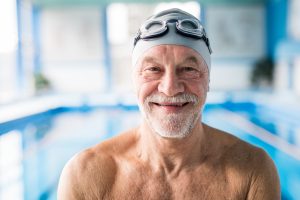Regular, meaningful physical activity provides many benefits for older adults (Bangsbo et al., 2019). However, older men can be a particularly hard-to-reach group when it comes to public health promotion and disease prevention initiatives (Bottorff et al., 2015; Carroll et al., 2014; Smith et al., 2007). In addition to general barriers older adults face (e.g., health-related limitations, fear of falling, and changes to the physical and social environment), there are barriers specific to older men that may limit their engagement in physical activity and healthy behaviours. For example, some challenges may be associated with male preferences for independence and solitude (Smith et al., 2007). Understanding how to design and deliver physical activity programs tailored to older men is important to counter distinct trends toward sedentary lifestyles as we age (Statistics Canada, 2015).
Emerging evidence suggests physical activity programs for men (of all ages) may be most effective when the approach caters to men’s interests and preferences (Bottorff et al., 2015). In particular, programs focused on engaging men through organized sport have been successful, which may be due to their generalized preference for structure, tangible outcomes, competitiveness, and demonstrating physical prowess (Bottorff et al., 2015). Do these findings also apply to older men specifically?
In a recent study (Deneau et al., 2019), we conducted in-depth interviews with 19 older men (aged 75-90 years) to determine what they desire in an ideal sport or physical activity program. Participants recommended seven common attributes that would enhance their engagement. We termed these the “7 A’s of Active Aging,” which are presented below.
Accompanied
- Most participants desired to engage in sport and physical activity with peers, or to be supervised by a knowledgeable instructor or coach. This finding is important considering the contrast to social norms that expect men to be independent and self-reliant. Older men may participate in greater levels of physical activity, and benefit more from participation, if there is a strong social component to programs.
Adapted
- Individually-tailored programs were of high importance to our participants. In order to capture the wide range of ability, interests, and circumstances among older men, it appears key to ask older men, “What will work for YOU?”
Alternative
- Similarly, our study participants requested that a variety of physical activity options, from competitive sport to active leisure pursuits, be offered across programs. For example, some men preferred basketball, some Tai-Chi, and others walking.
Affordable
- Affordability is a common barrier to physical activity among older adults (Franco et al., 2015). Many of our participants thought they needed a gym membership to achieve healthy aging. In reality, there are many forms of physical activity that, given the right circumstances, can contribute to health at minimal or no cost, such as walking. In addition to making physical activity programs more affordable, a strategy to spread the message that physical activity does not have to be expensive may be important.
Awareness
- Despite many available sport and physical activity programs for older adults, our participants were largely unaware of the opportunities available to them. We need to better understand how to communicate about sport and physical activity through methods and mediums (e.g., https://www.activeagingcanada.ca/) in which older adults are likely to engage.
Available
- Fundamentally, sport and physical activity programs tailored to older men (and older adults broadly) must be available. We recognize that there are limited resources for these purposes, especially in publically-funded health promotion systems. Efficient initiatives that aim to educate and empower older adults to engage in and maintain physical activity involvement on their own may be worth exploring in these circumstances.
Accessible
- Finally, our participants emphasized that programs must be accessible to the older adult population. This meant different things to different individuals. For example, accessible meant education to one man, and ease of transportation to program facilities to another.

There are many complexities to aging and health. In an ideal world, sport and physical activity programs for older adults would be highly individualized and adhere to the seven attributes discussed. There are several evolving Canadian programs that appear to be exemplars of the 7 A’s. Men on the Move in British Columbia is an example of a choice-based physical activity program in which activity coaches work with older adults to tailor active leisure plans based on participant preferences and circumstances. Men’s Sheds Canada hosts a wide range of social activities for men (e.g., wood carving, fixing bicycles, building model airplanes) that appear to function as beneficial active leisure in disguise. These programs have demonstrated high adherence rates and positive health and well-being outcomes (Mackey et al., 2019; Golding et al., 2007). We advocate for the adoption and further development of such strategies.
Certain forms of active leisure will work for some older men, whereas others will not. Rather than overemphasizing any single healthy behaviour, we encourage the promotion of as many alternatives as possible. Some men in our study desired more adapted and competitive sport programs, whereas others felt competitive sport was inherently risky or simply had no interest. For older men who would benefit from and wish to participate in sport, programs may experience improved adherence and outcomes when the seven suggestions from our older male participants are incorporated. Most importantly, we want to emphasize that the 7 A’s discussed should be considered as one piece of a more comprehensive and gender-sensitized health promotion strategy.